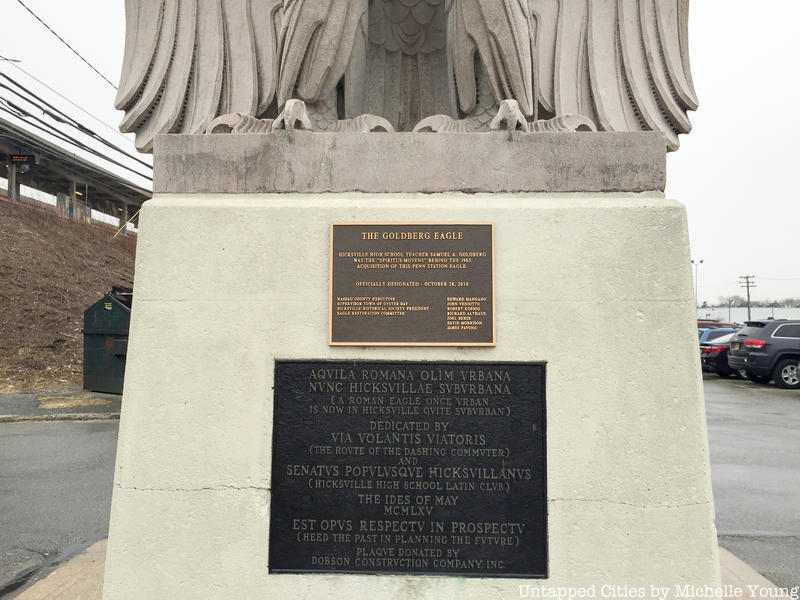There were originally 22 granite eagles located on the facades of the original Pennsylvania Station in New York City. The demolition of the train station is often credited with the birth of the preservation movement here. Among those shocked at the wholesale destruction of the train station designed by McKim, Mead and White were people and groups who were able to save decorative elements in time. The eagles have since became a symbol of the station, appearing all around the country. Most are displayed in traditionally honorable locations befitting their origins, but some are in rather unique spots. One of our favorites is in a parking lot of the Hicksville Long Island Railroad Station.
The eagle was saved by Samuel A. Goldberg, a Hicksville High School Latin teacher and his students. Goldberg is called the “spiritus movens” behind the reason the eagle was acquired in 1965, and conceived of the endeavor as a civic project for his class. After 18 months of “prodding” the Long Island Railroad, the 5,700 pound, five foot eagle was welcomed to this location on May 15, 1965 in a grand ceremony where the students dressed in togas and carried Latin signs. Even the eagle got a 10-foot long toga. Inscribed in Latin below the eagle were the words (translated): “A Roman eagle once urban is now in Hicksville, quite suburban.” The star-spangled banner was sung in both English and Latin, and then “three runners trotted into the lot carrying torches and wearing signs that read ‘I’m running to catch an eagle at Hicksville,'” according to the Hicksville Historical Society.
The plaque is entirely in Latin, with English translations, stating that the eagle was dedicated by “Via Volantis Viatoris” (The Route of the Dashing Commuter) on the Ides of May. “Est Opus Respectu in Prospectu” it also reads, “Heed the past in planning the future.” The pedestal had been donated by a Hicksville businessman and the plaque donated by Dobson Construction Company.

But by 2010, the eagle had deteriorated, losing its beak and getting a poor “beak”-lift following, and the granite had become dark from decades of pollution. In response, a local civic leader, Joel Berse formed an “Eagle Restoration Committee” and raised $5000 for its restoration through donations from the Hicksville Historical Society and Long Island Sunrise Trail Chapter of the National Railway Historical Society, along with $2500 from the Nassau County motel/hotel tax fund. A Manhattan sculptor was hired to repair and restore the eagle. An additional $2,250 was raised by three Newsday readers —one a former student of Goldberg —following an announcement of a shortfall: an additional $750 was needed to add a protective coating. That student, Sue Roach, told Newsday, “Maybe once in a lifetime you have a teacher you remember all your life,” Roach said. “Mr. Goldberg was that teacher for me.”
Another donor, Plainview attorney Jeff Kimmel, said he gave money because he just loved the eagle, and is an art and history fan. He felt that the first beak restoration looked like “a piece of mud they slapped on it.” Charles F. Connel, an office manager from Huntington he saw the eagle every time he went to the train station. With his interest in the mid-century, he found it “fascinating that it’s been there since 1965.”
On October 28, 2010, the eagle was rededicated and a new plaque affixed above the original. On May 15, 2015, Hicksville eagle fans marked the 50th anniversary of the arrival of the eagle to Hicksville in a moment which included the Richard Althaus, President of the Hicksville Historical Society, James Pavone, a past president of the Hicksville Chamber of Commerce, and David Morison, a retired LIRR Branch Line, all whom are listed on the new plaque.
Join us on our next tour of the Remnants of Penn Station, where you will see two of the original eagles up close!
Tour of the Remnants of Penn Station
Next, check out where the other 21 eagles of Penn Station ended up.






